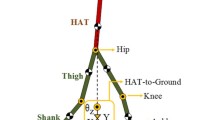Abstract
This study describes the development of a multibody foot–ground contact model consisting of spherical volumetric models for the surfaces of the foot. The developed model is two-dimensional and consists of two segments, the hind-foot, mid-foot, and fore-foot as one rigid body and the phalanges collectively as the second rigid body. The model has four degrees of freedom: ankle \(x\) and \(y\), foot orientation, and metatarsal-phalangeal joint angle. Three different types of contact elements are targeted: Kelvin–Voigt, linear volumetric, and hyper-volumetric. The models are kinematically driven at the ankle and the metatarsal joints, and simulated horizontal and vertical ground reaction forces as well as center of pressure location are compared against experimental quantities acquired from barefoot measurements during a human gait cycle. Parameter identification is performed for finding optimal contact parameters and locations of the contact elements. The hyper-volumetric foot–ground contact model was found to be a suitable choice for foot/ground interaction modeling within human gait simulations; this model showed 75 % and 62 % improvement on the matching quality over the point contact and linear volumetric models, respectively.





Similar content being viewed by others
References
Aerts, P., Ker, R.F., De Clercq, D., Ilsley, D.W., Alexander, R.M.: The mechanical properties of the human heel pad: a paradox resolved. J. Biomech. 28(11), 1299–1308 (1995)
Anderson, F.C., Pandy, M.G.: Dynamic optimization of human walking. J. Biomech. Eng. 123(5), 381–390 (2001)
Bisseling, R.W., Hof, A.L.: Handling of impact forces in inverse dynamics. J. Biomech. 39(13), 2438–2444 (2006)
Boos, M., McPhee, J.: Volumetric modeling and experimental validation of normal contact dynamic forces. J. Comput. Nonlinear Dyn. 8(2), 021006 (2013)
Carson, M., Harrington, M., Thompson, N., O’Connor, J., Theologis, T.: Kinematic analysis of a multi-segment foot model for research and clinical applications: a repeatability analysis. J. Biomech. 34, 1299–1307 (2001)
Cenk Güler, H., Berme, N., Simon, S.R.: A viscoelastic sphere model for the representation of plantar soft tissue during simulations. J. Biomech. 31(9), 847–853 (1998)
Cole, G.K., Nigg, B.M., van den Bogert, A.J., Gerritsen, K.G.M.: Lower extremity joint loading during impact in running. Clin. Biomech. 11(4), 181–193 (1996)
Dorn, T.W., Lin, Y.C., Pandy, M.G.: Estimates of muscle function in human gait depend on how foot–ground contact is modelled. Comput. Methods Biomech. Biomed. Eng. 15(6), 657–668 (2012)
Erdemir, A., Piazza, S.J.: Changes in foot loading following plantar fasciotomy: a computer modeling study. J. Biomech. Eng. 126(2), 237–243 (2004)
Geyer, H., Herr, H.: A muscle-reflex model that encodes principles of legged mechanics produces human walking dynamics and muscle activities. IEEE Trans. Neural Syst. Rehabil. Eng. 18(3), 263–273 (2010)
Gilchrist, L.A., Winter, D.A.: A two-part, viscoelastic foot model for use in gait simulations. J. Biomech. 29(6), 795–798 (1996)
Gonthier, Y., McPhee, J., Lange, C., Piedboeuf, J.C.: A contact modeling method based on volumetric properties. In: ASME Conference Proceedings, vol. 2005, pp. 477–486 (2005)
Gonthier, Y., McPhee, J., Lange, C., Piedboeuf, J.C.: A regularized contact model with asymmetric damping and dwell-time dependent friction. Multibody Syst. Dyn. 11(3), 209–233 (2004)
Hamner, S.R., Seth, A., Steele, K.M., Delp, S.L.: A rolling constraint reproduces ground reaction forces and moments in dynamic simulations of walking, running, and crouch gait. J. Biomech. 46(10), 1772–1776 (2013)
Holden, J.P., Orsini, J.A., Siegel, K.L., Kepple, T.M., Gerber, L.H., Stanhope, S.J.: Surface movement errors in shank kinematics and knee kinetics during gait. Gait Posture 5(3), 217–227 (1997)
Hunt, K., Crossley, F.: Coefficient of restitution interpreted as damping in vibroimpact. J. Appl. Mech. 7, 440–445 (1975)
Kecskemethy, A.: Integrating efficient kinematics in biomechanics of human motions. In: Procedia IUTAM, vol. 2, pp. 86–92 (2011)
Lopes, D.S.: Smooth convex surfaces for modeling and simulating multibody systems with compliant contact elements. Ph.D. Thesis, Instituto Superior Técnico, Universidade de Lisboa (2013)
MATLAB: version 8.0 (R2012b). The MathWorks Inc., Natick, Massachusetts, USA (2012)
Millard, M.: Mechanics and control of human balance. Ph.D. thesis, University of Waterloo, Canada (2011)
Neptune, R.R., Wright, I.C., Den Bogert, A.J.V.: A method for numerical simulation of single limb ground contact events: application to heel-toe running. Comput. Methods Biomech. Biomed. Eng. 3(4), 321–334 (2000)
Peasgood, M., Kubica, E., McPhee, J.: Stabilization of a dynamic walking gait simulation. J. Comput. Nonlinear Dyn. 2(1), 65–72 (2007)
Petersen, W.: A volumetric contact model for planetary rover wheel/soil interaction. Ph.D. thesis, University of Waterloo, Canada (2012)
Petersen, W., McPhee, J.: A nonlinear volumetric contact model for planetary rover wheel/soil interaction. In: ASME International Design Engineering Technical Conferences, Portland, USA (2013)
Sandhu, S., McPhee, J.: A two-dimensional nonlinear volumetric foot contact model. In: ASME International Mechanical Engineering Congress & Exposition, Vancouver, Canada (2010)
Scott, S.H., Winter, D.A.: Biomechanical model of the human foot: kinematics and kinetics during the stance phase of walking. J. Biomech. 26(9), 1091–1104 (1993)
Shourijeh, M.S.: Optimal control and multibody dynamic modelling of human musculoskeletal systems. Ph.D. Thesis, University of Waterloo, Canada (2013)
Shourijeh, M.S., McPhee, J.: Efficient hyper-volumetric contact dynamic modelling of the foot within human gait simulations. In: ASME International Design Engineering Technical Conferences, Portland, USA (2013). doi:10.1115/DETC2013-13446
Shourijeh, M.S., McPhee, J.: Forward dynamic optimization of human gait simulations: a global parameterization approach. J. Comput. Nonlinear Dyn. 9(3), 031018 (2014)
Shourijeh, M.S., McPhee, J.: Optimal control and forward dynamics of human periodic motions using Fourier series for muscle excitation patterns. J. Comput. Nonlinear Dyn. 9(2), 021005 (2014)
Srinivasan, S., Raptis, I., Westervelt, E.R.: Low-dimensional sagittal plane model of normal human walking. J. Biomech. Eng. 130(5), 051017 (2008)
Lugris, U., Carlin, J., Pamies-Vila, R., Font-Llagunes, J.M., Cuadrado, J.: Solution methods for the double-support indeterminacy in human gait. Multibody Syst. Dyn. 30(3), 247–263 (2013)
Valiant, G.A.: A determination of the mechanical characteristics of the human heel pad in vivo. Ph.D. Thesis, The Pennsylvania State University, USA (1984)
Vila, R.: Application of multibody dynamics techniques to the analysis of human gait. Ph.D. Thesis, Technical University of Catalonia, Spain (2012)
Wang, J.M., Hamner, S.R., Delp, S.L., Koltun, V.: Optimizing locomotion controllers using biologically-based actuators and objectives. ACM Trans. Graph. 31(4), 25 (2012)
Wilson, C., King, M.A., Yeadon, M.R.: Determination of subject-specific model parameters for visco-elastic elements. J. Biomech. 39(10), 1883–1890 (2006)
Wojtyra, M.: Multibody simulation model of human walking. Mech. Based Des. Struct. Mach. 31(3), 357–379 (2003)
Zajac, F.E., Neptune, R.R., Kautz, S.A.: Biomechanics and muscle coordination of human walking, part I: introduction to concepts, power transfer, dynamics and simulations. Gait Posture 16(3), 215–232 (2002)
Zajac, F.E., Neptune, R.R., Kautz, S.A.: Biomechanics and muscle coordination of human walking, part II: lessons from dynamical simulations and clinical implications. Gait Posture 17(1), 1–17 (2003)
Zhou, X., Draganich, L.F., Amirouche, F.: A dynamic model for simulating a trip and fall during gait. Med. Eng. Phys. 24(2), 121–127 (2002)
Acknowledgements
Authors would like to thank the ASME for granting the permission to reuse some of the text and figures of their previously published work [28]. We thank Mr. Michael Boos for providing us with the linear volumetric contact components in MapleSim. We also wish to thank the Human Movement Biomechanics Lab at the University of Ottawa for assistance with the data collection. The first author would like to thank Dr. Willem Petersen for the helpful discussion of the hyper-volumetric contact modeling approach. The authors also wish to acknowledge the Natural Sciences and Engineering Research Council of Canada (NSERC) for funding support of this study.
Author information
Authors and Affiliations
Corresponding author
Appendix: Optimal contact parameters
Appendix: Optimal contact parameters
Optimal parameters of the three different contact models are presented here.
Rights and permissions
About this article
Cite this article
Shourijeh, M.S., McPhee, J. Foot–ground contact modeling within human gait simulations: from Kelvin–Voigt to hyper-volumetric models. Multibody Syst Dyn 35, 393–407 (2015). https://doi.org/10.1007/s11044-015-9467-6
Received:
Accepted:
Published:
Issue Date:
DOI: https://doi.org/10.1007/s11044-015-9467-6




